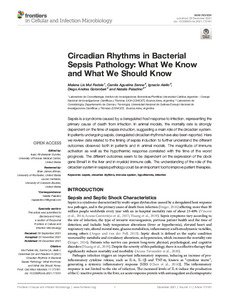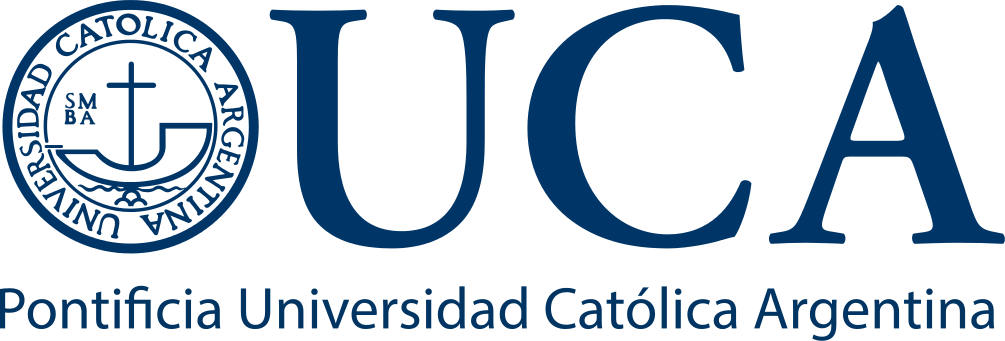Por favor, use este identificador para citar o enlazar este ítem:
https://repositorio.uca.edu.ar/handle/123456789/13955| Campo DC | Valor | Lengua/Idioma |
|---|---|---|
| dc.contributor.author | Mul Fedele, Malena Lis | es |
| dc.contributor.author | Senna, Camila Agustina | es |
| dc.contributor.author | Aiello, Ignacio | es |
| dc.contributor.author | Golombek, Diego A. | es |
| dc.contributor.author | Paladino, Natalia | es |
| dc.date.accessioned | 2022-05-13T12:43:14Z | - |
| dc.date.available | 2022-05-13T12:43:14Z | - |
| dc.date.issued | 2021 | - |
| dc.identifier.citation | Mul Fedele, M. L. et al. Circadian rhythms in bacterial sepsis pathology : what we know and what we should know [en línea]. Frontiers in cellular and infection microbiology. 2021, 11. doi: 10.3389/fcimb.2021.773181. Disponible en: https://repositorio.uca.edu.ar/handle/123456789/13955 | es |
| dc.identifier.issn | 2235-2988 (on line) | - |
| dc.identifier.uri | https://repositorio.uca.edu.ar/handle/123456789/13955 | - |
| dc.description.abstract | Abstract: Sepsis is a syndrome caused by a deregulated host response to infection, representing the primary cause of death from infection. In animal models, the mortality rate is strongly dependent on the time of sepsis induction, suggesting a main role of the circadian system. In patients undergoing sepsis, deregulated circadian rhythms have also been reported. Here we review data related to the timing of sepsis induction to further understand the different outcomes observed both in patients and in animal models. The magnitude of immune activation as well as the hypothermic response correlated with the time of the worst prognosis. The different outcomes seem to be dependent on the expression of the clock gene Bmal1 in the liver and in myeloid immune cells. The understanding of the role of the circadian systemin sepsis pathology could be an important tool to improve patient therapies. | es |
| dc.format | application/pdf | es |
| dc.language.iso | eng | es |
| dc.publisher | Frontiers | es |
| dc.rights | Acceso abierto | * |
| dc.rights.uri | http://creativecommons.org/licenses/by-nc-sa/4.0/ | * |
| dc.source | Frontiers in cellular and infection microbiology. 2021, 11 | es |
| dc.subject | RITMO CIRCADIANO | es |
| dc.subject | SISTEMA INMUNOLOGICO | es |
| dc.subject | HIPOTERMIA | es |
| dc.subject | SEPSIS | es |
| dc.subject | INFECCIONES | es |
| dc.title | Circadian rhythms in bacterial sepsis pathology : what we know and what we should know | es |
| dc.type | Artículo | es |
| dc.identifier.doi | 10.3389/fcimb.2021.773181 | - |
| dc.identifier.pmid | 34956930 | - |
| uca.disciplina | MEDICINA | es |
| uca.issnrd | 1 | es |
| uca.affiliation | Fil: Mul Fedele, Malena Lis. Pontificia Universidad Católica Argentina. Facultad de Ciencias Médicas. Instituto de Investigaciones Biomédicas. Laboratorio de Cronofisiología; Argentina | es |
| uca.affiliation | Fil: Mul Fedele, Malena Lis. Consejo Nacional de Investigaciones Científicas y Técnicas; Argentina | es |
| uca.affiliation | Fil: Senna, Camila Agustina. Universidad Nacional de Quilmes. Departamento de Ciencia y Tecnología. Laboratorio de Cronobiología; Argentina | es |
| uca.affiliation | Fil: Senna, Camila Agustina. Consejo Nacional de Investigaciones Científicas y Técnicas; Argentina | es |
| uca.affiliation | Fil: Aiello, Ignacio. Universidad Nacional de Quilmes. Departamento de Ciencia y Tecnología. Laboratorio de Cronobiología; Argentina | es |
| uca.affiliation | Fil: Aiello, Ignacio. Consejo Nacional de Investigaciones Científicas y Técnicas; Argentina | es |
| uca.affiliation | Fil: Golombek, Diego A. Universidad Nacional de Quilmes. Departamento de Ciencia y Tecnología. Laboratorio de Cronobiología; Argentina | es |
| uca.affiliation | Fil: Golombek, Diego A. Consejo Nacional de Investigaciones Científicas y Técnicas; Argentina | es |
| uca.affiliation | Fil: Paladino, Natalia. Universidad Nacional de Quilmes. Departamento de Ciencia y Tecnología. Laboratorio de Cronobiología; Argentina | es |
| uca.affiliation | Fil: Paladino, Natalia. Consejo Nacional de Investigaciones Científicas y Técnicas; Argentina | es |
| uca.version | publishedVersion | es |
| item.languageiso639-1 | en | - |
| item.fulltext | With Fulltext | - |
| item.grantfulltext | open | - |
| crisitem.author.dept | Instituto de Investigaciones Biomédicas - BIOMED | - |
| crisitem.author.dept | Laboratorio de Cronofisiología | - |
| crisitem.author.dept | Consejo Nacional de Investigaciones Científicas y Técnicas | - |
| crisitem.author.dept | Facultad de Ciencias Médicas | - |
| crisitem.author.parentorg | Facultad de Ciencias Médicas | - |
| crisitem.author.parentorg | Instituto de Investigaciones Biomédicas - BIOMED | - |
| crisitem.author.parentorg | Pontificia Universidad Católica Argentina | - |
| Aparece en las colecciones: | Artículos | |
Ficheros en este ítem:
| Fichero | Descripción | Tamaño | Formato | |
|---|---|---|---|---|
| circadian-rhythms-bacterial-sepsis.pdf | 1,6 MB | Adobe PDF |  Visualizar/Abrir |
Visualizaciones de página(s)
63
comprobado en 27-abr-2024
Descarga(s)
38
comprobado en 27-abr-2024
Google ScholarTM
Ver en Google Scholar
Altmetric
Altmetric
Este ítem está sujeto a una Licencia Creative Commons

